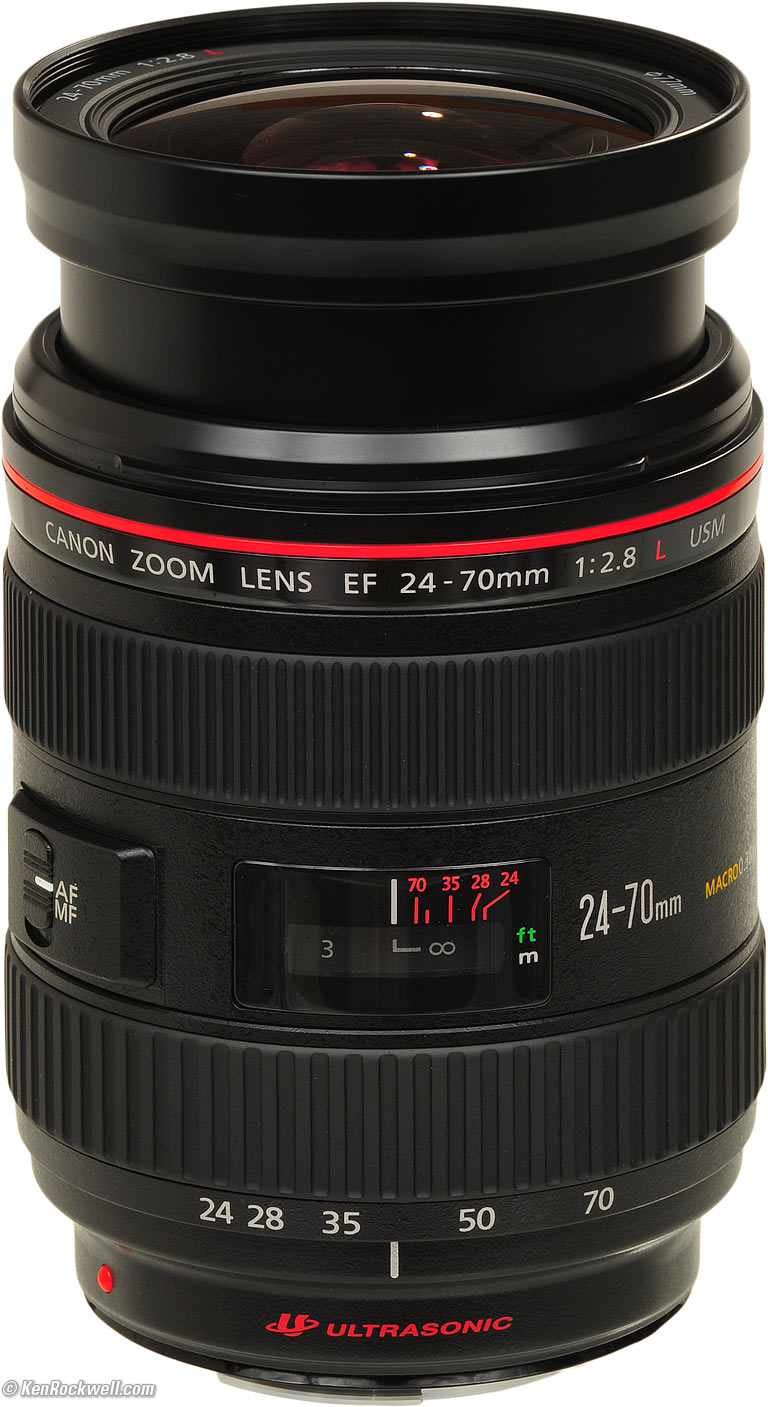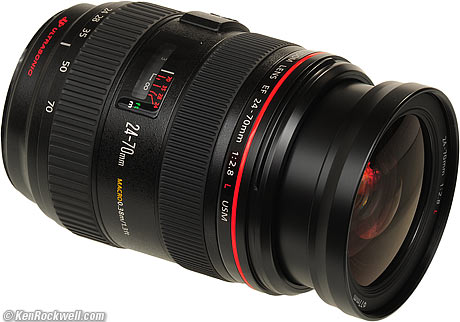¶ Canon 24-70mm F/2.8L USM Lens

(From Canon lens literature) This new lens does what many pros thought couldn't be done - replace the previous L-series 28-70 f/2.8 lens with something even better. Extended coverage to an ultra-wide-angle 24mm makes it ideal for digital as well as film shooters, and the optics are even better than before with two Aspherical elements and a totally new UD glass element. It's now sealed and gasketed against dust and moisture, and a new processing unit makes the AF faster than ever.
Test Notes
(Sub-frame, on an EOS-20D)
As anyone who's shot with one will attest (see the user reviews below), the Canon 24-70mm f/2.8 lens is just an exceptional optic. This was clearly evident in our DxO tests as well. On the sub-frame EOS-20D, the lens was tack sharp across the entire frame wide open, from 24-50mm. At 70mm, it softened slightly at f/2.8, but stopping down just to f/4.0 it was again excellent, and at f/5.6 it was superb. Chromatic aberration was moderate at 24mm, but decreased to an exceptionally low level by 35mm, and stayed very low all the way out to 70mm. Geometric distortion was low as well, changing gradually and proportionately from 0.5% barrel distortion at 24mm to about 0.2% pincushion at 70mm. (The zero distortion point came at about 45mm.) Shading (frequently referred to as vignetting) was also exceptionally low, at 1/4 of a stop wide open, decreasing to less than 1/10 stop at f/4 and above.
Spending a lot of money on a lens isn't always a guarantee of good performance, but in the case of the Canon 24-70mm f/2.8, every penny of its price is more than justified.
Full-Frame Test Notes:

When we moved to looking at the 24-70's behavior on a full-frame camera (we tested on an EOS-5D), we had been spoiled a bit by its stellar performance on the sub-frame EOS-20D. Still, it was surprising just how well the lens handled the significantly larger frame area. Most impressive was how well it managed to hold sharpness in the corners when wide open. There was definitely more softness there than we saw on the EOS-20D, but it really wasn't bad, the corners only being notably soft at 24 and 70mm. We did find though, that we had to stop down all the way to f/8 to completely eradicate the corner softness. At f/8 though, images were just incredibly sharp across the entire frame area.
As you might expect, maximum chromatic aberration increased noticeably over what we'd seen on the 20D, but here again, the 24-70 still did quite well. Maximum CA was never more than what we'd rate as "moderate" (0.06% or less) at any aperture or focal length, and the average CA was quite low across the board, indicating that the worst of the CA was confined to the edges of the image.
Geometric distortion was higher than we saw on the 20D, but not by as much as we would have expected. Worst-case barrel distortion increased only from 0.5 to 0.6% at 24mm, while worst-case pincushion did a little worse, increasing from 0.2 to 0.5% at 70mm.
Shading or vignetting was where the 24-70mm struggled the most to adequately cover the larger frame size. On the 20D, shading was never more than 1/4 f-stop, but on the 5D, the light falloff at 24mm and f/2.8 was on the order of 0.85 stop, a very noticeable level. The good news though, is that shading decreases fairly rapidly as the lens is stopped down, reaching a level of about 1/3 stop at f/8 at 24mm, and proportionately lower at longer focal lengths.
The Canon 24-70mm f/2.8 is the first lens we've tested on a full-frame camera, so as this is written, we don't have results from other lenses to compare it with. Even without a basis for comparison though, it's clear that the 24-70mm easily justifies its price. Its one area of weakness was shading at maximum aperture: It was stellar in virtually every other attribute.
¶ Lens Specifications:
| Lens Specifications | |
|---|---|
| Name | Canon EF 24-70mm f/2.8L USM |
| Image Circle | 35mm |
| Type | Standard Zoom |
| Focal Length | 24 - 70mm |
| APS Equivalent | 38 - 112mm |
| Max Aperture | f/2.8 |
| Min Aperture | f/22 |
| Diaphragm Blades | 8 |
| Lens Construction | 16 elements in 13 groups, including 3 asperical elements and 1 UD element |
| Diagonal Angle of View(Based on image circle) | 74 to 29 degrees |
| Focus Details | Full-time manual focus and USM |
| Front Element Rotation | No |
| Zoom System | Rotary |
| Closest Focus | 0.38m / 14.96 in. |
| Magnification Ratio | 0.16x / 1:6.3 |
| Filter Size | 77mm |
| Dimensions(Length x Diameter) | 123.5mm x 83.2mm / 4.9 in. x 3.3 in. |
| Weight | 950g / 33.5 oz |
| Notes | |
| Typical Online Price | US$1350 |